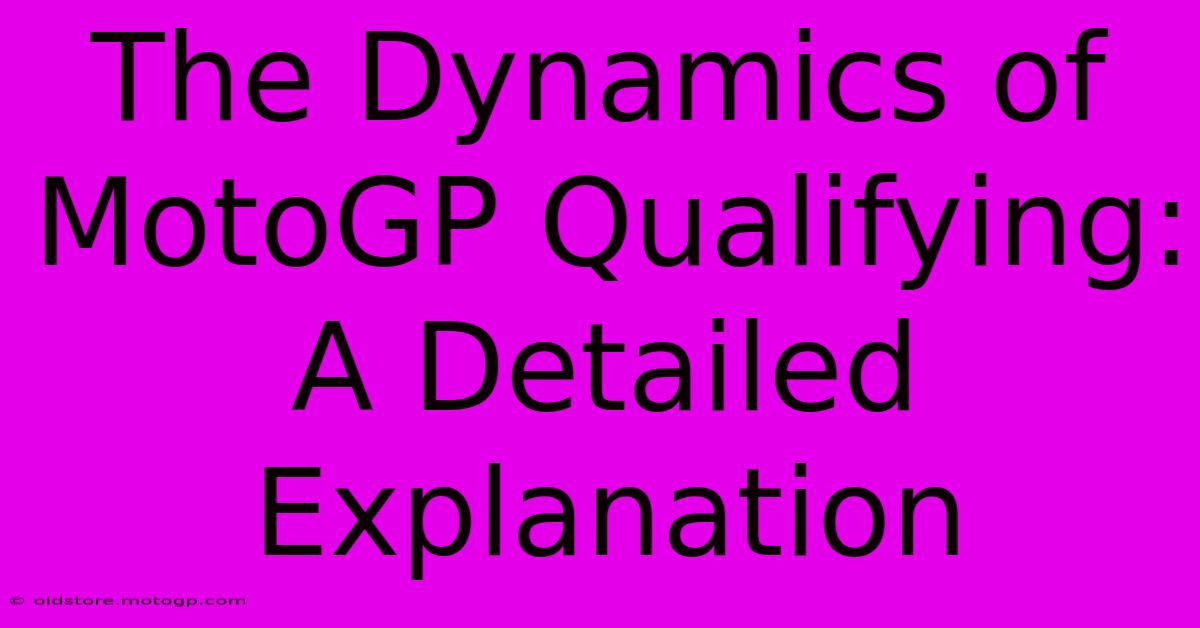The Dynamics Of MotoGP Qualifying: A Detailed Explanation

Table of Contents
The Dynamics of MotoGP Qualifying: A Detailed Explanation
MotoGP, the pinnacle of motorcycle road racing, captivates audiences worldwide with its breathtaking speeds and nail-biting competition. But beyond the Sunday race lies a crucial element that often dictates the outcome: qualifying. Understanding the dynamics of MotoGP qualifying is key to appreciating the strategic depth and intense pressure faced by riders and teams. This detailed explanation will break down the process, highlighting the key factors that determine grid positions and ultimately, race results.
The Qualifying Format: A Step-by-Step Breakdown
The current MotoGP qualifying format is a multi-stage process designed to create drama and excitement while effectively separating the fastest riders from the rest of the pack. It typically unfolds as follows:
1. Free Practice Sessions (FP1-FP3):
These sessions are crucial for data gathering and bike setup. Teams meticulously analyze telemetry data, tire wear, and rider feedback to optimize performance for qualifying. While not directly impacting the grid position, FP sessions are vital for laying the groundwork for success in the subsequent stages.
2. Qualifying 1 (Q1):
The riders who finish outside the top 10 combined times from the three free practice sessions participate in Q1. This session is a 15-minute sprint to secure a place in Q2. The top two riders from Q1 automatically progress to the next stage. The pressure is immense; a single mistake can mean the difference between a front-row start and battling in the midfield. Strategic tire management and track conditions play a significant role here.
3. Qualifying 2 (Q2):
The top 10 riders from the combined free practice sessions, along with the two qualifiers from Q1, compete in Q2. This 15-minute session determines the coveted front-row positions and the all-important starting grid for the race. The tension is palpable; every tenth of a second counts. Slipstreaming (drafting behind another rider to gain speed) becomes a crucial tactical element here.
Key Factors Influencing Qualifying Performance
Several factors significantly influence a rider's qualifying performance:
1. Rider Skill and Experience:
The inherent skill of the rider is paramount. Precision, consistency, and the ability to push the bike to its absolute limits under immense pressure are crucial. Experienced riders often possess a superior understanding of track characteristics and bike setup.
2. Motorcycle Performance and Setup:
The performance of the motorcycle itself is a major determinant. Teams spend countless hours fine-tuning the bike's setup to optimize performance for qualifying conditions. This includes factors such as engine mapping, suspension settings, and aerodynamics.
3. Tire Choice and Management:
Tire selection is critical. The choice of tire compound significantly impacts grip, performance, and longevity. Tire management during the qualifying sessions is crucial to ensure peak performance throughout.
4. Track Conditions:
Weather plays a crucial role. Track temperature, humidity, and even the presence of wind can drastically alter the bike's handling and performance. Adaptability and the ability to react to changing conditions are essential for success.
5. Slipstreaming and Teamwork:
Slipstreaming is a common tactic in Q2, where riders draft behind each other to gain a speed advantage. This requires careful coordination and timing. Teamwork within a manufacturer is also essential; data sharing and collaborative efforts can lead to significant performance gains.
The Importance of Qualifying in the Grand Prix
A strong qualifying performance is crucial for race success. Starting from the front row provides significant advantages, including:
- Clean track: Avoiding the chaos of the first few corners.
- Early race advantage: A strong start can dictate race strategy and momentum.
- Reduced risk of collisions: Avoiding the congested midfield.
In conclusion, MotoGP qualifying is a complex and strategic battleground. It is a spectacle that showcases the pinnacle of motorcycle racing talent and technological prowess. Understanding the dynamics of qualifying provides a deeper appreciation for the intense pressure, precise calculations, and sheer skill required to secure a favorable starting position and ultimately, victory.

Thank you for visiting our website wich cover about The Dynamics Of MotoGP Qualifying: A Detailed Explanation. We hope the information provided has been useful to you. Feel free to contact us if you have any questions or need further assistance. See you next time and dont miss to bookmark.
Featured Posts
-
F1 Shuttles Your Ticket To A Seamless Race Day
Feb 23, 2025
-
Moto Gp Qualifying How Technology Plays A Role
Feb 23, 2025
-
Maximize Your Cota Experience With Convenient Parking
Feb 23, 2025
-
Navigate F1 Austin Parking With Ease
Feb 23, 2025
-
Get Immersed In The Action Austin Gp Sprint Race Vip Access
Feb 23, 2025
